Menu
Download the accompanying materials to this lesson plan - sign up here
Resources and materials for ESL Kids teachers
The beginning of your lesson is extremely important: you set the tone of your lesson and get everyone in the right frame of mind for learning English. It is also an opportunity to check homework and review previous lessons.
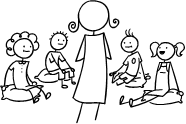 These activities can be done in the following order at the start of your lesson:
These activities can be done in the following order at the start of your lesson:
1. Welcoming
Greet the students by name as they enter the classroom and gesture for them to sit down. If you have space on the floor, it's a good idea to have a cushion for each student as this makes sitting arrangements easy to organize. Try and arrange the cushions beforehand spaced out in a fan-shape around you.
2. Name Tags
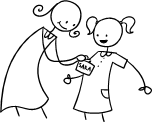 Before class prepare some name tags (stickers or pin-on tags) with each student's name written in lower case letters. Sit down with your students and lay out the name tags in front of you. Pick up each tag and call out the name. Try and encourage each student to put their hand up and say "yes". Hand over the tags and help to pin / stick on. Later on as your students recognize their written names you can have each student in turn pick out their own name tag.
Before class prepare some name tags (stickers or pin-on tags) with each student's name written in lower case letters. Sit down with your students and lay out the name tags in front of you. Pick up each tag and call out the name. Try and encourage each student to put their hand up and say "yes". Hand over the tags and help to pin / stick on. Later on as your students recognize their written names you can have each student in turn pick out their own name tag.
3. Greetings:
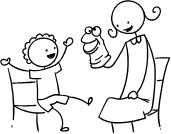 For younger students (7s and under):
For younger students (7s and under):
Use a glove puppet (such as a Sesame Street puppet) to greet the students. Keep him in a cloth bag. Bring out the bag, open it enough to see in and shout into the bag the puppet's name (e.g. "Cookie Monster!"). Then move your ear to the opening to listen - nothing. Go to each student and encourage them to shout the puppet's name into the bag - each time nothing happens. Finally, get all the students together to shout the name at the same time. This time the puppet wakes up and jumps out of the bag! The puppet then chats to each student: "Hello", "What's your name?" "Goodbye / See you" before going back into the bag and back to sleep.
For older students (8 and older):
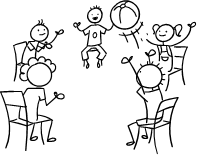 Sit everyone in a circle around you and throw (or roll) a ball to each student randomly. As you do so, ask questions, starting from the simple (What's your name?, How are you?) to more involved questions (Where do you live?, What is your favorite food, Do you like Superman?, Can you fly?, etc.). You can review questions from previous lessons and introduce new questions. Generally, I try to introduce one or two new questions a month - the first time they are introduced ask everybody the question, then always review in the next lessons.
Sit everyone in a circle around you and throw (or roll) a ball to each student randomly. As you do so, ask questions, starting from the simple (What's your name?, How are you?) to more involved questions (Where do you live?, What is your favorite food, Do you like Superman?, Can you fly?, etc.). You can review questions from previous lessons and introduce new questions. Generally, I try to introduce one or two new questions a month - the first time they are introduced ask everybody the question, then always review in the next lessons.
4. Sing "Hello Song" or a review song
Sit in a circle and sing along to the song. Encourage students to clap along or pat their laps in time with the music. The Hello Song is a good song to start the lesson with, especially as it has an accompanying Goodbye song to sing at the end of the lesson.
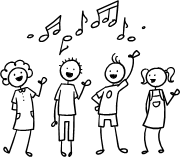 Lyrics for "The Hello Song"
Lyrics for "The Hello Song"
Hello, hello,
How are you today?
Hello, hello,
How are you today?
I’m fine, thank you,
I’m fine, thank you,
I’m fine, thank you,
And how about you?
Hello, hello,
How are you today?
I’m fine, thank you,
And how about you?
Gestures for "The Hello Song"
These are quite straight forward. First time you play the song do the gestures and encourage everyone to do them with you.
We also have a video that you can stream in class to sing along with (Internet connection required):
5. Read a Classroom Reader again
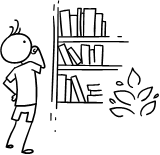 As you progress through the lessons you will start to build up a catalog of classroom readers. Kids love going back to old stories and reading through them again. Invite a student to pick a classroom reader and read through it as a class. Make the story as interactive as possible by asking questions (e.g. what colors there are, the names of different objects, etc.) and getting students to speculate what is going to happen next in the story.
As you progress through the lessons you will start to build up a catalog of classroom readers. Kids love going back to old stories and reading through them again. Invite a student to pick a classroom reader and read through it as a class. Make the story as interactive as possible by asking questions (e.g. what colors there are, the names of different objects, etc.) and getting students to speculate what is going to happen next in the story.
6. Homework check
Check each student's homework set in the last lesson. Ask each student some questions about their homework worksheet (e.g. "what color is it?"), give lots of praise, and then put some kind of mark on the homework sheet (e.g. a sticker, a stamp or draw a smiley face). Finally, tell your students to put their homework back into their bags.

7. Do "Exercise Routine" activity
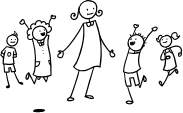 Say the following and have your students follow your lead: "Stand up (teacher stands and so does everyone else), "Hands up / hands down" (x 3-5), "Jump" (x3-5), "Run! / Stop!" (x3-5), "Turn around! / Stop!" (x3-5), finally "Sit down". Throughout the course you can introduce other commands, such as "Hop", "Star Jump", "Wiggle", "Crouch" and so on.
Say the following and have your students follow your lead: "Stand up (teacher stands and so does everyone else), "Hands up / hands down" (x 3-5), "Jump" (x3-5), "Run! / Stop!" (x3-5), "Turn around! / Stop!" (x3-5), finally "Sit down". Throughout the course you can introduce other commands, such as "Hop", "Star Jump", "Wiggle", "Crouch" and so on.
Extra activity: Once your students have got to know these exercises you can play "Teacher Says" using these actions.
This is basicallythe game Simon Says but using the words "Teacher says" instead. The teacher tells the students to do an action and they do ask asked (e.g. "Teacher says ... jump 3 times"). The teacher keeps on giving instructions with different actions using "Teacher says ...". At some point the teacher gives a command without using the phrase "Teacher says" (e.g. "Hop 5 times") and the students mustn't do that action - they have to stay still. Any students that do the action have to sit out for the rest of the game. The last student standing is the winner.
8. Review past lessons
Reviewing past lessons is very important - students need constant practice of new vocab, structures, songs, games and so on. Always review parts of your last lesson as well as some parts from other previous lessons. You can spend 5-10 minutes reviewing - it's fine to recycle games and activities from your past lessons to review as kids enjoy playing familiar games (although be careful not to play a game to death!).
Note: You can also include review activities in the main body of your lesson. Kids can have short attention spans so it's good to be able to pull out lots of activities during different stages of the lesson.
What's in the bag?
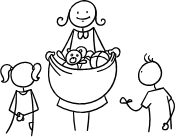 This is a great activity to do at the beginning of your lessons. Fill a large cloth bag with items from your previous lessons (e.g. plastic fruit, animals, etc.). You can also throw in a few other objects (e.g. an eraser, a plastic bottle, a plastic cup - anything lying around (and safe!)). Show the bag to your students and shake it to rattle the objects inside. Pull out different objects, teach/elicit their names, have students hold and pass the objects around. You can even have students pull objects out of the bag. Pull out 1 or 2 objects per student. Finally, place the objects around the classroom and have each student retrieve each object as you call out its name and put it back in the bag.
This is a great activity to do at the beginning of your lessons. Fill a large cloth bag with items from your previous lessons (e.g. plastic fruit, animals, etc.). You can also throw in a few other objects (e.g. an eraser, a plastic bottle, a plastic cup - anything lying around (and safe!)). Show the bag to your students and shake it to rattle the objects inside. Pull out different objects, teach/elicit their names, have students hold and pass the objects around. You can even have students pull objects out of the bag. Pull out 1 or 2 objects per student. Finally, place the objects around the classroom and have each student retrieve each object as you call out its name and put it back in the bag.
Knock-Knock
This can be used at the beginning of each class. Teach the students to knock on the door before entering the classroom. There are 2 variations for the next step:
Spin the bottle
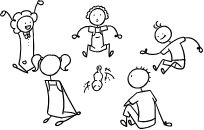 Sit students in a circle with a bottle in the middle. Teacher Spins the bottle. When it stops spinning the student it is pointing to has to answer a question. If the answer is correct then that student can spin the bottle. This is a good class warm up activity (e.g. How are you? What's your name? What is this? (show an object or flashcard) Do you like ___?, etc.).
Sit students in a circle with a bottle in the middle. Teacher Spins the bottle. When it stops spinning the student it is pointing to has to answer a question. If the answer is correct then that student can spin the bottle. This is a good class warm up activity (e.g. How are you? What's your name? What is this? (show an object or flashcard) Do you like ___?, etc.).
Talk about the weather (do after you have taught the weather lesson plan).
Review the day, date and month (do after you have taught the days and months lesson plan).
You'll need a large calendar for this (ideally with the days and months written in English). Before class, set the calendar to the front page. Site everyone down facing you and turn the page of the calendar to January. Ask "Which month is this?" and have everyone shout out "January!". Then ask, "It it January now"? Elicit "Yes" or "No" depending on the month you are in. Keep turning the pages and eliciting months until you reach your current month.
Then ask "What day is it today?" pointing to the days at the top of the page. Get everyone to shout out the day.
Next, point down the column of dates and ask "What is the date today?" and elicit the correct date.
Finally, invite a student to come up to the calendar and stick a star or sticker onto the correct date.
Additionally, you can sing the "Days of the Week" song or "Months March" song.
The end of the lesson gives the teacher the opportunity to assign homework and do a quick review. Students can say goodbye in a positive atmosphere and therefore look forward to their next lesson.
These activities can be done in the following order at the end of your lesson:
1. Assign Homework
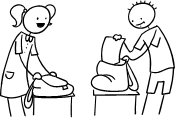 Each week give out a homework worksheet for your students to take home. Hold up the homework worksheet and model how to do it. Give out the worksheets and say "Put your homework in your bags" and help them to do so - this is important as they will probably want to start coloring them right away.
Each week give out a homework worksheet for your students to take home. Hold up the homework worksheet and model how to do it. Give out the worksheets and say "Put your homework in your bags" and help them to do so - this is important as they will probably want to start coloring them right away.
Note: If possible, encourage the parents to help out as much as possible with their child's homework - it is a great way to have your students practice the target language outside of class.
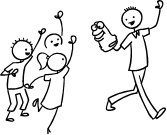 2. Say Goodbye
2. Say Goodbye
For younger students (under 7s):
Glove puppet. Take out the bag again and get everyone to wake up the glove puppet by shouting its name into the bag (e.g. "Cookie Monster!"). Bring out the puppet and go through the same routine as in the warm up - go to each S and say hello, ask their name and the say goodbye / see you. Then put the puppet back in the bag (back to sleep).
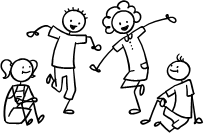 For older students (7 and older):
For older students (7 and older):
Play "Stand on one leg questions": Get everyone to stand on one leg. Ask each student in turn a question (either from the warm-up questions or a review question from the lesson). If they get the question right they can sit down. If they get it wrong they must remain standing on one leg until the turn comes around to them again. This should be fun and quick - hopefully your students will all be sitting down soon enough!
3. Sing "Goodbye Song" or a review song
The "Goodbye Song" is a good way to sign off the class. Sit together in a circle and sing and clap along. You can also use a different song, especially if your students love a particular song.
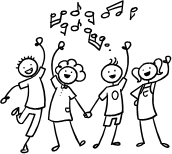 Lyrics for "The Goodbye Song"
Lyrics for "The Goodbye Song"
Goodbye, goodbye,
See you again.
Goodbye, goodbye,
See you again.
It’s time to go,
It’s time to go,
It’s time to go,
See you next time.
Goodbye, goodbye,
See you again.
It’s time to go,
See you next time.
Gestures for "The Goodbye Song"
These are quite straight forward. First time you play the song do the gestures and encourage everyone to do them with you.
We also have a video that you can stream in class to sing along with (Internet connection required):
5. Do "Quick Check"
Time to leave the class. Make sure everything is put away and the students have gathered their belongings. Have them line up at the door and place yourself between the door and the students. For each student check one new word (e.g. hold up a color or fruit and ask "What's this?"). For very young kids you can hold up one of the worksheets you did in the lesson and ask them to touch an object (e.g. "Touch the melon"). When they give you an answer say goodbye and let them leave.
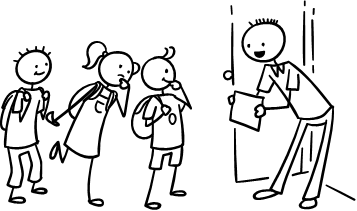
 Found a mistake?
Found a mistake?
Please let us know
Full access to all resources on ESL KidStuff including lesson plans, flashcards, worksheets, craft sheets,
song downloads, classroom readers, flashcards app and songs app.